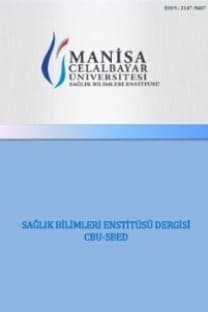Aksaray İlindeki Polikiliniğe Baş Ağrısı ile Başvuran Adölesanlarda Migren Prevalansı ve Etki Eden Sosyodemografik Faktörler
migren, adölesan, çocuk, teknoloji, bilgisayar
Prevalence of migraine and the affecting sociodemographic factors in adolescents admitted to the polyclinic with headache in Aksaray Province
___
- Lewis, D.W, Ashwal, S, Dahl, G, Dorbad, D, Practice parameter: Evaluation of children and adolescents with recurrent headaches, Neurology, 2002, 59, 490-498.
- Bugdayc,i R, Ozge, A, Sasmaz, T, Kurt, A.O, Kaleagasi, H, Karakelle, A, Tezcan, H, Siva, A, Prevalence and factors affecting headache in Turkish school children, Pediatrics International, 2005, 47, 316-322.
- Aslantaş, D, Metintaş, S, Unsal, A, Kalyoncu, C, Eskişehir kırsal kesim oğrencilerinde başağrısı sıklığı ve etkileyen faktörler, Sürekli Tıp Eğitimi Dergisi, 2007, 16, 1-5.
- Bektaş, Ö, Uğur, C, Gençtürk, Z.B, Aysev, A, Sireli, Ö, Deda, G, Relationship of childhood headaches with preferences in leisure time activities, depression, anxiety and eating habits: A population-based, cross-sectional study, Cephalalgia, 2015, 35, 527-537.
- Schwedt, T.J, Chronic migraine, British Medical Journal, 2014, 348, 1416.
- Lewis, D.W, Toward the definition of childhood migraine, Current Opinion in Pediatrics, 2004, 16, 628-36. Anttila, P, Metsahonkala, L, Sillanpää, M, Long-term trends in the incidence of headache in Finnish school children, Pediatrics, 2006, 117, 1197-1201.
- Cevoli S, Sancisi E, Pierangeli G, Grimaldi D, Zanigni S, Nicodemo M, Cortelli P, Montagna P, Chronic daily headache: risk factors and pathogenetic considerations, Neurological Sciences, 2006, 27(2), 168-173.
- Poyrazoğlu, H.G, Kumandas, S, Canpolat, M, Gümüs, H, Elmali, F, Kara, A, Per, H, The prevalence of migraine and tension-type headache among schoolchildren in Kayseri, Turkey: an evaluation of sensitivity and specificity using multivariate analysis, Journal of Child Neurology, 2015, 30, 889-895.
- Evcili, G, Ak, H, Göçmen, A.Y, Atalay, T, Tanık, N, Kış, N, Ergenlik Çağındaki Çocuklarda Migren Prevalansı ve Etki Eden Sosyodemografik Faktörler, Acıbadem Üniversitesi Sağlık Bilimleri Dergisi, 2014, 1, 77-80.
- Tepecik Böyükbaş, İ, Çıtak Kurt, A.N, Tural Hesapçıoğlu, S, Uğurlu, M, Relationship between headache and Internet addiction in children, Turkish Journal of Medical sciences, 2019, 49, 1292-1297.
- Stovner, Lj, Hagen, K, Jensen, R, Katsarava, Z, Lipton, R, Scher, A, et al., The global burden of headache: a documentation of headache prevalence and disability worldwide, Cephalalgia, 2007, 27, 193-210.
- Schüz, J, Mobile phone use and exposures in children, Bioelectromagnetics, 2005, 7, 45-50.
- Söderqvist, F, Hardell, L, Carlberg, M, Hansson Mild, K, Ownership and use of wireless telephones: a population-based study of Swedish children aged 7-14 years, British Medical Journal Public Health, 2007, 7, 105. Röösli, M, Frei, P, Mohler, E, Hug, K, Systematic review on the health effects of exposure to radiofrequency electromagnetic fields from mobile phone base stations, The Bulletin of the World Health Organization, 2010, 88, 887-896.
- Carter, B, Rees, P, Hale, L, Bhattacharjee, D, Paradkar, MS, Association between portable screen-based media device access or use and sleep outcomes: a systematic review and meta-analysis, JAMA Pediatrics, 2016, 170, 1202-1208.
- Wood, B, Rea, M.S, Plitnick, B, Figueiro, M.G, Light level and duration of exposure determine the impact of self-luminous tablets on melatonin suppression, Applied Ergonomics, 2013, 44, 237-240.
- Cain, N, Gradisar, M, Electronic media use and sleep in school-aged children and adolescents: A review, Sleep Medicine, 2010, 735–742.
- Hillert, L, Akerstedt, T, Lowden, A, Wiholm, C, Kuster, N, Ebert, S, et al., The effects of 884 MHz GSM wireless communication signals on headache and other symptoms: an experimental provocation study, Bioelectromagnetics, 2008, 29(3), 185-196
- Thomee, S, Eklöf, M, Gustafsson, E, Nilsson, R, Hagberg, M, Prevalence of perceived stress, symptoms of depression and sleep disturbances in relation to information and communication technology (ICT) use among young adults – an explorative prospective study, Computers in Human Behavior, 2007, 23, 1300–1321.
- Valentini, E, Curcio, G, Moroni, F, Ferrara, M, De Gennaro, L, Bertini, M, Neurophysiological effects of mobile phone electromagnetic fields on humans: a comprehensive review, Bioelectromagnetics, 2007, 28, 415–432.
- Rubin, G.J, Hillert, L, Nieto-Hernandez, R, van Rongen, E, Oftedal, G, Do people with idiopathic environmental intolerance attributed to electromagnetic fields display physiological effects when exposed to electromagnetic fields? A systematic review of provocation studies, Bioelectromagnetics, 2011, 32, 593–609.
- Ghorbani, N.R, Heidari, R.N, Effects of information and communication technology on youth's health knowledge, Asia Pacific Journal of Public Health, 2011, 23, 363-368.
- Nuutinen, T, Roos, E, Ray, C, Villberg, J, Välimaa, R, Rasmussen, M, Holstein, B, Godeau, E, Beck, F, Léger, D, Tynjälä, J, Computer use, sleep duration and health symptoms: a cross-sectional study of 15-year olds in three countries, The International Journal of Public Health, 2014, 59(4), 619-628.
- Juang, K.D, Wang, S.J, Fuh, J.L, Lu, S.R, Chen, Y.S, Association between adolescent chronic daily headache and childhood adversity: a community-based study, Cephalalgia, 2004, 24(1), 54-59.
- Bigal, M.E, Lipton, R.B, Modifiable risk factors for migraine progression, Headache, 2006, 46, 1334- 1343.
- Houle, T, Nash, J.M, Stress and headache chronification, Headache, 2008, 48, 40-44.
- ISSN: 2147-9607
- Yayın Aralığı: Yılda 4 Sayı
- Başlangıç: 2014
- Yayıncı: Manisa Celal Bayar Üniversitesi Sağlık Bilimleri Enstitüsü
DİLEK ONGAN, Berna AĞIL, Gamze YURTDAŞ, Hüsnü YILMAZ, Emre ONGAN, Devrim DÖLEK
PEKTUS EKSKAVATUM VE PEKTUS KARİNATUMLU HASTALARDA GÖRÜLEN POSTÜR BOZUKLUKLARI
Nuray ALACA, İhsan ALACA, Atılay MORGÜL, Mustafa YÜKSEL
Ramazan Rüçhan KAYA, AHMET ALKAN
Dikkat Eksikliği ve Hiperaktivite Bozukluğu (DEHB) Olan Çocukların Fiziksel Aktivite Düzeyleri
Eosinofilik Granülomatoz Polyangiitis Sonrası Görülen Sitomegalovirus Enfeksiyonu - Olgu Sunumu
Kezban Armağan ALPTÜRKER, Özgül SOYSAL GÜNDÜZ, Nurullah AKKOÇ
Psikiyatri Kliniğinde Yatan Hastaların Bakım Gereksinimleri ve Özsaygı Düzeylerinin İncelenmesi
Ceyda BAŞOĞUL, Aysun KALENDEROĞLU
Kanserin Önlenmesi ve Tedavisinde Polifenollerin Rolü
ŞENAY BURÇİN ALKAN, Neslişah RAKICIOĞLU
Manyetik Kateter Yönlendirme Sistemleri
Özge AKBÜLBÜL, Mert ŞENER, Gökhan ÖZDEMİR, Aylin ŞENDEMİR, Ece BAYIR, Tuncay GÖKSEL, Haydar Soydaner KARAKUŞ, MUTLU BOZTEPE, Levent ÇETİN, Gökmen Atakan TÜRKMEN, BARIŞ OĞUZ GÜRSES, AYSUN BALTACI
Pektus Ekskavatum ve Pektus Karinatumlu Hastalarda Görülen Postür Bozuklukları
